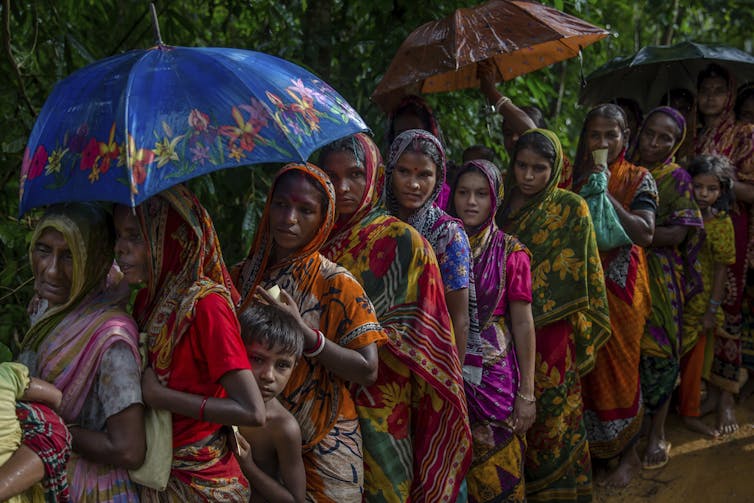
Today, 65 million people live as refugees or are displaced within their home countries – more than at any other point since the U.N. Refugee Agency began collecting data. Many countries have opened their borders to those displaced by war and famine, but struggle to handle the large influx.
This global crisis is often misunderstood as an overwhelming challenge for which no one can offer a satisfactory solution. But there are a set of tools that would help us, as a global society, take major leaps forward in addressing this crisis. I’m talking about predictive analytics — the statistical science (some would say art) that mines current and past data to predict future outcomes.
As a long-standing practitioner of predictive analytics, I know the field is ready to take on this challenge. But political and financial roadblocks are keeping us from addressing the crisis.
Refugee flows
All the rage for the better part of the recent decade, predictive analytics are now used in a wide range of fields: predicting which students are in danger of dropping out of a university, helping Los Angeles social workers find possible cases of fraud and shaving millions of unnecessary miles per year off UPS drivers’ routes. Data from the past helps the algorithms anticipate problems before they arise.
When it comes to refugees, a lack of forethought has made an already unstable geopolitical situation even worse. Few host countries had the ability to absorb refugees, and nobody fully anticipated the challenges the front-line states of Jordan, Lebanon, Turkey and Greece would face as temporary homes for thousands fleeing to Europe. When many European states stopped accepting migrants, that only exacerbated the strain on front-line states.
Meanwhile, even willing countries like Germany left thousands stuck in refugee camps far longer than anyone thought would be required.
Migration data is already being collected by a variety of sources, including national population censuses, sample surveys, smartphones, border crossings and administrative sources like population registers.
Such rolling data could be a game-changer for officials on the front lines of the crisis. Sophisticated analytics could help experts confidently chart where refugees are likely to head next. Policymakers, spotting signs of a future influx, might reroute refugees to different countries. This real-time data could also help organizations quickly and accurately shunt money and goods to the locales that need them the most.
Success may not come easy. But if the predictions are even small improvements on current “best guesses,” refugees would benefit from not being bottled up in overcrowded refugee camps.
In theory, perhaps algorithms could account for the political will, public opinion and the logistical capabilities of a potential host state. Similarly sophisticated statistical models have long been used to study interstate conflicts and civil wars. If front-line states are at breaking point or distracted by an ongoing regional crisis, then refugee aid organizations would be forewarned to develop alternative routes equipped to deal with refugees.
Obstacles ahead
It requires political will for countries to work with multistate and intergovernmental organizations, share migrant pattern data, and decide how to provide resources to host countries who need them most. But, to put it bluntly, figuring out how to welcome the most refugees possible is not a top priority for most countries.
There are also major technical challenges that will need to be addressed if an international effort around predictive analytics is to succeed. One of the biggest is establishing a system to house all of the data securely. Accidental data releases could lead to targeted violence against these vulnerable populations.
Of course, these solutions would also take a hefty financial investment. Both private entrepreneurs and multinational organizations like the U.N. have devoted more attention but limited resources to the problem. Last June, Data for Democracy, a data science initiative, won a U.N.-sponsored challenge to estimate and locate internally displaced persons. Machine learning and vast amounts of online data were an integral part of the winning solution. However, challenges like these rely on volunteers rather than a permanent arm of the U.N.
![]() Providing humanitarian assistance to those most in need – there could be no higher purpose. While implementing a data-driven solution to the refugee problem may sound daunting, the hard work could pay off in the future – for the children of today’s Syrian and Rohingya refugees, for people fleeing the threat of climate change, or for other threats that we have not yet foreseen.
Providing humanitarian assistance to those most in need – there could be no higher purpose. While implementing a data-driven solution to the refugee problem may sound daunting, the hard work could pay off in the future – for the children of today’s Syrian and Rohingya refugees, for people fleeing the threat of climate change, or for other threats that we have not yet foreseen.
Anirudh V. S. Ruhil, Professor of Leadership & Public Affairs, Ohio University
This article was originally published on The Conversation.
